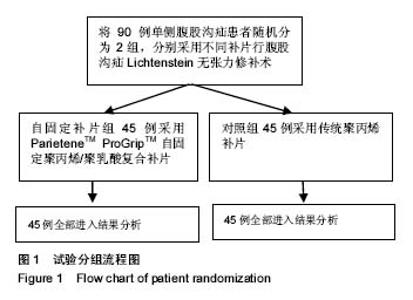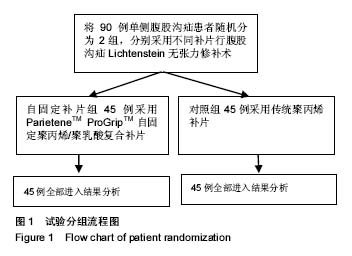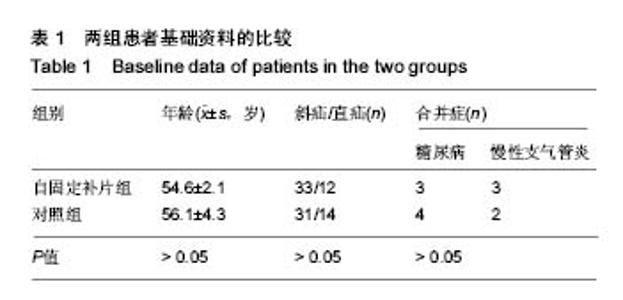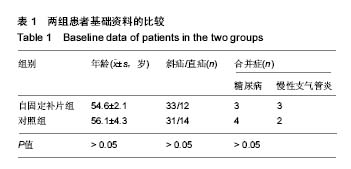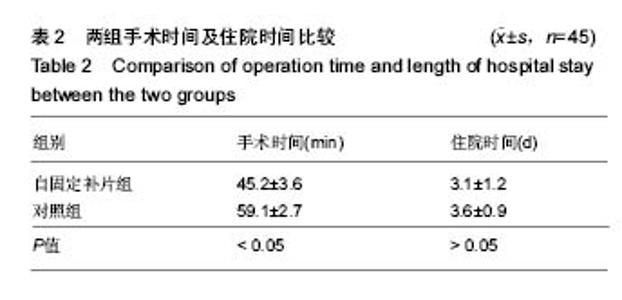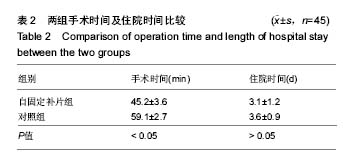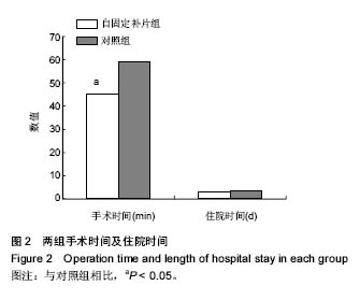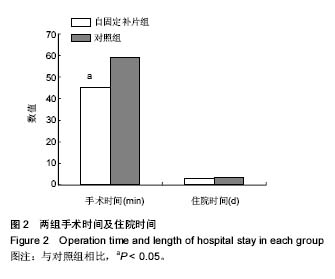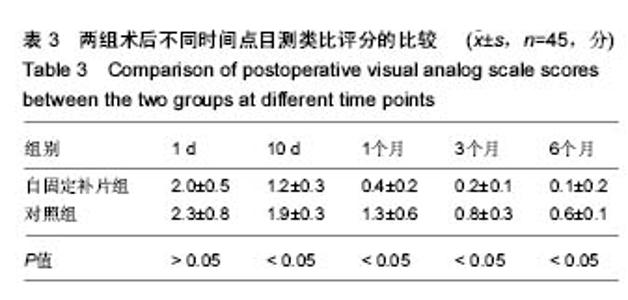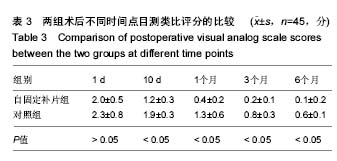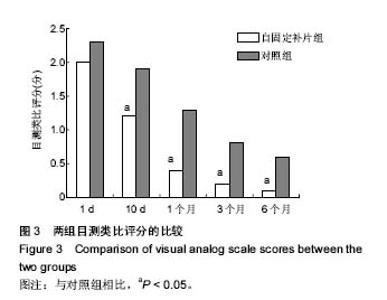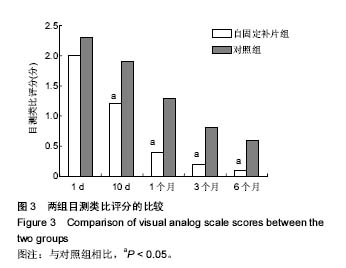| [1]Lichtenstein IL,Shulman AG,Amid PK,et al.The tension-free hernioplasty.Am J Surg.1989;157(2):188-193.[2]Muysoms FE,Vanlander A,Ceulemans R,et al.A prospective, multicenter, observational study on quality of life after laparoscopic inguinal hernia repair with ProGrip laparoscopic, self-fixating mesh according to the European Registry for Abdominal Wall Hernias Quality of Life Instrument.Surgery. 2016;160(5):1344-1357. [3]Wang Y,Zhang X.Short-term results of open inguinal hernia repair with self-gripping Parietex ProGrip mesh in China: A retrospective study of 90 cases.Asian J Surg. 2016;39(4): 218-224. [4]Guérin G,Bourges X,Turquier F.Biomechanical evaluation of three fixation modalities for preperitoneal inguinal hernia repair: a 24-hour postoperative study in pigs. Med Devices (Auckl).2014;7:437-444. [5]李金龙,房学东.疝修补术中应用人工假体材料相关并发症[J].中华疝和腹壁外科杂志:电子版,2013,7(1):10-11.[6]胡明高,李向国,郭彪,等.开放式与腹腔镜全腹膜外疝修补术的对照研究[J].中国普外基础与临床杂志,2014,21(11):1431-1435.[7]Chastan P.Tension free open inguinal hernia repair using an innovative self gripping semi-resorbable mesh.J Minim Access Surg.2006;2(3):139-143.[8]朱海峰,王福荣,董文亮,等.自固定补片与普通平片在无张力疝修补术中的临床研究[J].中华疝和腹壁外科杂志(电子版), 2014, 8(4):339,341.[9]周琳.局麻自粘合半可吸收补片(Progrip)应用于成人腹股沟疝的临床研究[J].中医临床研究,2016,8(15):127-128.[10]Wauschkuhn CA,Schwarz J,Boekeler U,et al.Laparescopic inguinal hernia repair:gold standardin bilateral hernia repairResults ofmore than 2 800 patients in comparison to literature.Surg Endosc.2010;23(3):3O-31.[11]Kapiris S,Mavromatis T,Andrikopoulos S,et al.Laparescopic transabdominal preperitoneal hernia repair(TAPP):stapling the mesh is not mandatory[.J Lapareendosc Adv Surg Tech A.2009;19(3):419-422.[12]杨帆.无张力疝修补术后并发症分析[J].中华疝和腹壁外科杂志:电子版,2013,7(1):7-9.[13]马宏光.再谈腹股沟疝术后慢性疼痛[J].中华疝和腹壁外科杂志:电子版,2011,5(4):384-388.[14]Kingsnorth A,GingeH-Littlejohn M,Nienhuijs S,et al. Randomized contmHed muhicenter international clinical trial of self-gripping Parietex PmGripTM polyester mesh versus lightweight po lyprepylene mesh in open inguinal hernia repair: interim results at 3 months.Hernia.2012;16(3):287-294.[15]付鸿江.自固定轻量补片在腹腔镜下腹股沟疝修补中的应用[J].中华疝和腹壁外科杂志:电子版,2014,8(1):60-62.[16]李继东,耿天祥.ProGrip自固定补片在腹股沟疝无张力修补术中的应用体会[J].中华疝和腹壁外科杂志:电子版,2015,9(4):59.[17]Pielaciński K,Dabrowski W,Szczepanik AB,et al.Self-fixating Progrip implant used in the laparoscopic totally extraperitoneal technique for inguinal hernia repair. Pol Merkur Lekarski.2011;31(186):345-347. [18]Kapischke M,Schulze H,Caliebe A.Self-fixating mesh for the Lichtenstein procedure--a prestudy. Langenbecks Arch Surg. 2010;395(4):317-322.[19]Klobusicky P,Feyerherd P.Innovation in Laparoscopic Inguinal Hernia Reparation-Initial Experiences with the Parietex Progrip Laparoscopic(™) - Mesh.Front Surg.2015;2:28. [20]Nikkolo C,Vaasna T,Murruste M,et al.Three-year results of a randomized study comparing self-gripping mesh with sutured mesh in open inguinal hernia repair.J Surg Res.2017; 209: 139-144. [21]Rönkä K,Vironen J,Kössi J,et al.Randomized Multicenter Trial Comparing Glue Fixation, Self-gripping Mesh, and Suture Fixation of Mesh in Lichtenstein Hernia Repair(FinnMesh Study).Ann Surg. 2015;262(5):714-719.[22]Ozmen J,Choi V,Hepburn K,et al.Laparoscopic Totally Extraperitoneal Groin Hernia Repair Using a Self-Gripping Mesh: Clinical Results of 235 Primary and Recurrent Groin Hernias.J Laparoendosc Adv Surg Tech A. 2015;25(11): 915-919. [23]Verhelst J,de Goede B,Kleinrensink GJ,et al.Open incisional hernia repair with a self-gripping retromuscular Parietex mesh: a retrospective cohort study.Int J Surg.2015;13:184-188.[24]司磊,艾合买提江•艾海提.自粘式补片和普通平片在Lichtenstein无张力疝修补术中的应用比较[J].中国现代普通外科进展,2016, 19(10):803-804.[25]Klobusicky P,Hoskovec D.Reduction of chronic post-herniotomy pain and recurrence rate. Use of the anatomical self-gripping ProGrip laparoscopic mesh in TAPP hernia repair. Preliminary results of a prospective study.Wideochir Inne Tech Maloinwazyjne. 2015;10(3): 373-381.[26]Gys T,Gys B,Lafullarde T.The use of a self-gripping mesh in open inguinal hernia repair. A prospective observational single surgeon study.Acta Chir Belg.2013;113(3):192-195.[27]Batabyal P,Haddad RL,Samra JS,et al.Inguinal hernia repair with Parietex ProGrip mesh causes minimal discomfort and allows early return to normal activities.Am J Surg.2016;211(1): 24-30. [28]阎立昆,姚建锋,王小强,等.自固定补片与普通聚丙烯补片临床应用对比分析[J].中华疝和腹壁外科杂志:电子版, 2013,8(1): 11-13.[29]Molegraaf MJ,Grotenhuis B,Torensma B,et al.The HIPPO Trial, a Randomized Double-blind Trial Comparing Self-gripping Parietex Progrip Mesh and Sutured Parietex Mesh in Lichtenstein Hernioplasty: A Long-term Follow-up Study.Ann Surg.2017.[Epub ahead of print][30]Pierides G,Scheinin T,Remes V,et al.Randomized comparison of self-fixating and sutured mesh in open inguinal hernia repair. Br J Surg.2012;99(5):630-636. [31]Chatzimavroudis G,Papaziogas B,Koutelidakis I,et al. Lichtenstein technique for inguinal hernia repair using polypropylene mesh fixed with sutures vs. self-fixating polypropylene mesh: a prospective randomized comparative study.Hernia.2014;18(2):193-198.[32]王家胜,杨雷,康小兰,等.自固定补片与普通缝合补片用于开放式腹股沟疝修补的Meta分析[J].中国组织工程研究, 2015,19(34): 5552-5558. |
